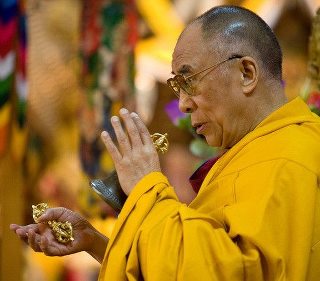
His Holiness the Dalai Lama
The Dalai Lama and Me
April 30, 2012 9:43 am; The Huffington Post, April 28, 2012, by Peter Worthington, Co-founder of the Toronto Sun.
It may sound impertinent, but the most benign, non-violent symbol it the world today is, arguably, the Dalai Lama. To some, by his demeanor and example, he is mindful of what Jesus Christ represents — not passive, but radiating goodness, philosophic understanding of man’s foibles, spiritual but very human, with a gentle sense of humor and appealing humility.
The Dalai Lama’s quick visit to Ottawa this weekend is to attend a conference of world parliamentarians on Tibet — what to do, if anything. He met Prime Minister Stephen Harper who, more than many previous PMs, doesn’t duck meeting or being photographed with the Dalai Lama for fear of offending China.
After all, like Nelson Mandela, the Dalai Lama is an honorary Canadian citizen.
Obviously, I am an unapologetic admirer of His Holiness — and of Tibetans, who take their lead from him and adamantly oppose the cultural (and physical) genocide China is practicing in Tibet, yet remain non-violent and law-abiding. Such restraint is unusual, especially when China’s Tibetan victims push a million.
Perhaps another reason for my admiration approaching affection for the Dalai Lama is journalistic. I was in India around the time the Dalai Lama escaped from Tibet over the Himalayas into India with the Chinese army on his heels.
Ostensibly, I was covering U.S. President Dwight Eisenhower’s visit to India in 1959, and I broke off to visit the Dalai Lama in Bombay. India was fearful of angering China by giving him sanctuary, and he agreed not to give interviews, but to hold occasional audiences.
Again I was in northeast India in 1962 when China invaded India and easily captured the North East Frontier Agency (NEFA). By then, the Dalai Lama and Tibetan refuges were living in Dharamsala, north of New Delhi. I hopped a train and went to visit him.
Dharamsala was a seething centre of impoverished Tibetan refugees trying to sell jade jewelry, knitted goods, artifacts on roadside blankets. They suffered from heat. The Dalai Lama stayed in what seemed a summer house, complete with cottage veranda. He didn’t get many foreign visitors, and even then seemed startlingly young considering his importance as a symbol. And he was young — 27.
His English was tentative, and he had a translator, with whom he seemed to get impatient. In fragile English, he answered questions before they were translated. He was worried that the humidity and heat of India was unhealthy for Tibetans, and expressed interest in establishing a Tibetan refugee community somewhere in the Canadian Rockies.
He was interested in the world, and seemed to relish chatting with a foreigner who did not treat him as a god-king. He joked, if I remember correctly, that as a teenager in Lhasa he tried to drive a car and hit a concrete block or wall “and in one accident damaged 50 percent of the cars in Tibet.”
Then, as now, he had an infectious laugh, and took his role seriously, but not himself. I remember at the time, I was indignant at what the Chinese were doing to his country, and how the world hesitated from outright condemnation.
The young Dalai Lama showed no overt anger at China, just resolve that there had to be a solution. After all, one doesn’t get angry that a scorpion behaves like a scorpion. The Chinese were the Chinese, and under communism would not change.
At the time, there was pressure on Indian Prime Minister Nehru to give the Dalai Lama sanctuary. I had also interviewed Nehru, and while I thought he was too generous about the Chinese invading, he remained adamant that he had no choice but to give the Dalai Lama sanctuary.
I told the Dalai Lama this, and he chuckled, and said something about not wanting to make Nehru’s position more difficult by saying provocative things. When I left to catch the train back to New Delhi, I thought the Dalai Lama was a bit wistful. He had a hunger for outside opinions, a curiosity about what was happening in the world (the Cuban missile crisis was on), and his last words were again to express interest about possibly living in the Canadian Rockies.
I wonder if he still thinks of the Rockies?
http://tibet.net/2012/04/30/the-dalai-lama-and-me/